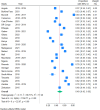Factors influencing exclusive breastfeeding in Sub-Saharan Africa: analysis of demographic and health surveys
- PMID: 40375216
- PMCID: PMC12080165
- DOI: 10.1186/s12889-025-23045-z
Factors influencing exclusive breastfeeding in Sub-Saharan Africa: analysis of demographic and health surveys
Abstract
Background: Low rates of exclusive breastfeeding (EBF) contribute to high child mortality rates. This study aimed to identify the prevalence and factors influencing EBF in SSA using nationally representative data from the Demographic Health Survey program (DHS).
Methods: A cross-sectional study design using the most recent DHS data of 25 SSA countries from 2010 to 2023. A total of 17,431 women aged 15-49 years with infants below six months were included. Pearson's chi-square and multivariable logistic regression tests were used to test the association and predictors of EBF at a 95% confidence interval (CI) at a significance level of p ≤ 0.05.
Results: The pooled prevalence of EBF across 25 Sub-Saharan African countries was 49%, ranging from 83% in Burundi to 19% in Gabon. Multivariable logistic regression revealed that older infants aged 2-3 months (AOR = 0.511, 95% CI: 0.458-0.570) and 4-5 months (AOR = 0.176, 95% CI: 0.156-0.198) had significantly lower odds of EBF compared to newborns (0-1 month). Overweight infants (AOR = 0.800, 95% CI: 0.647-0.987) and those experiencing fever (AOR = 0.805, 95% CI: 0.704-0.921) or diarrhea (AOR = 0.799, 95% CI: 0.683-0.935) were also less likely to be exclusively breastfed. Mothers with higher education (AOR = 0.700, 95% CI: 0.516-0.948) had reduced EBF odds. Wealthier households demonstrated higher odds (middle: AOR = 1.411, 95% CI: 1.185-1.681; richer: AOR = 1.539, 95% CI: 1.254-1.889; richest: AOR = 1.455, 95% CI: 1.119-1.892). Rural, the East (AOR = 2.588, 95% CI: 2.162-3.099) or West Africa (AOR = 3.018, 95% CI: 2.464-3.697) significantly increased EBF odds compared to urban areas and Central Africa, respectively.
Conclusion: This study highlights key factors influencing EBF in 25 Sub-Saharan African countries. The findings provide complex interplay of individual and community factors influencing EBF. To improve EBF, targeted interventions should focus on: supporting mothers of older infants, integrating counseling into child health services, addressing wealth gaps, and implementing region-specific strategies. Strengthening health systems and community engagement is crucial to overcome barriers and promote equitable breastfeeding practices.
Keywords: Demographic health survey; Exclusive breastfeeding; Multilevel analysis; Predictors; sub-Saharan Africa.
© 2025. The Author(s).
Conflict of interest statement
Declarations. Ethics approval and consent to participate: This research made use of the DHS database, a five-year survey carried out in LMIC. Following subject registration and submission via their website, ICF International approved access and usage of the dataset. The DHS website has thorough information on the approach and ethical issues. Since the used data for this study were secondary data and publicly accessible, individual consent to participate in the study was not required. The study obtained DHS Programme approval. All data were carefully managed guaranteeing privacy all through the processing and analysis stages. Consent for publication: Not applicable. Competing interests: The authors declare no competing interests.
Figures
Similar articles
-
Determinants of prolonged exclusive breastfeeding among children aged 6-23 months in 21 sub-saharan African countries: evidence from nationally representative data.Ital J Pediatr. 2025 Jan 23;51(1):12. doi: 10.1186/s13052-025-01856-5. Ital J Pediatr. 2025. PMID: 39849591 Free PMC article.
-
Determinants of exclusive breastfeeding among infants under six months in Nepal: multilevel analysis of nationally representative household survey data.BMC Public Health. 2024 Sep 9;24(1):2456. doi: 10.1186/s12889-024-19963-z. BMC Public Health. 2024. PMID: 39251930 Free PMC article.
-
Determinants of formula feeding among mothers with infants and young children in six Sub Sahara African countries: Multilevel analysis of data from demographic and health survey.PLoS One. 2024 Dec 26;19(12):e0311945. doi: 10.1371/journal.pone.0311945. eCollection 2024. PLoS One. 2024. PMID: 39724177 Free PMC article.
-
Early Initiation of Breastfeeding and Exclusive Breastfeeding in Anglophone and Francophone West African Countries: Systematic Review and Meta-Analysis of Prevalence.Matern Child Nutr. 2025 Apr;21(2):e13792. doi: 10.1111/mcn.13792. Epub 2025 Jan 7. Matern Child Nutr. 2025. PMID: 39764605 Free PMC article.
-
Early cessation of exclusive breastfeeding and associated factors in Ethiopia: a systematic review and meta-analysis.Front Nutr. 2025 Apr 25;12:1500077. doi: 10.3389/fnut.2025.1500077. eCollection 2025. Front Nutr. 2025. PMID: 40395551 Free PMC article.
References
-
- World Health Organization; UNICEF. Global Nutrition Targets 2025: Breastfeeding Policy Brief, WHO/NMH/NHD/14.7. 2012;14.7.
-
- Global Breastfeeding Collective; UNICEF; World Health Organization. Global Breastfeeding Scorecard 2023: Rates of Breastfeeding Increase Around The World Through Improved Protection and Support. available at https://www.who.int/publications/i/item/WHO-HEP-NFS-21.45. 2023.
-
- Louis-Jacques AF, Stuebe AM. Enabling breastfeeding to support lifelong health for mother and child. Obstet Gynecol Clin N Am. 2020;47(3):363–81. - PubMed
-
- Victora CG, Bahl R, Barros AJ, França GV, Horton S, Krasevec J, et al. Breastfeeding in the 21st century: epidemiology, mechanisms, and lifelong effect. Lancet (London England). 2016;387(10017):475–90. - PubMed
-
- Boix-Amoros A, Collado MC, Van’t Land B, Calvert A, Le Doare K, Garssen J, et al. Reviewing the evidence on breast milk composition and immunological outcomes. Nutr Rev. 2019;77(8):541–56. - PubMed
MeSH terms
LinkOut - more resources
Full Text Sources
Medical
Research Materials


